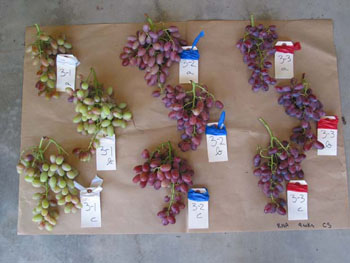Matthew Fidelibus and Stephen Vasquez, University of California
Table grapes are generally grown in regions having a warm, dry climate. Such conditions contribute to good productivity and discourage the development of rots, but they also inhibit the production and retention of the pigments that color red- and black-fruited grapes. Moreover, the use of plant growth regulators (PGRs), such as gibberellic acid (GA3) or forchlorfenuron (CPPU), to increase berry size, may further suppress color. Therefore, to ensure timely and uniform color development, it is often necessary to apply other PGRs.
The most widely used PGR for improving grape berry color is ethephon (Ethrel®, Bayer Crop Science, Research Triangle Park, NC). The degradation of ethephon releases ethylene, a plant hormone that stimulates pigment accumulation in grapes. One or two pints of Ethrel® is applied at veraison (5%-30% berry color) in a spray volume that is sufficient to achieve thorough fruit coverage. Late or excessive applications of ethephon can result in soft berries, which decreases their post-harvest shelf life.
Recently, another active ingredient, abscisic acid (ABA), has become available as an agrochemical (ProTone™, Valent BioSciences, Libertyville, IL). Like ethephon, the application of ABA accelerates and improves the coloring of grapes (Figure 1). Abscisic acid is generally applied at veraison, when about 50% of the berries have softened, but post-veraison applications also may be effective. Typical applications range from 75 to 250 grams of active ingredient (g/a.i.) per acre, in a spray volume that is sufficient to ensure thorough coverage of the clusters. Suboptimal coverage may result in unsatisfactory results.
Caution: Plant growth regulators (PGRs), including ethephon and abscisic acid, are classified as pesticides and are subject to the same rigorous regulatory framework. Plant growth regulators may not be approved for grapes in certain regions, or for particular cultivars of grapes. The unapproved use of PGRs on grapes may result in contaminated crops with illegal pesticide residues, so readers should seek guidance from a qualified local pest control adviser before applying any PGR or other type of pesticide to their grapes.
Recommended Resources
Using Gibberellic Acid to Reduce Cluster Compactness in Grapes
Using Plant Growth Regulators to Increase the Size of Table Grape Berries
Using Plant Growth Regulators to Promote Bud Break in Grapes
Table Grapes – Potential for Maryland, University of Maryland
Table Grapes: A Potential Alternative Crop, Texas A&M University
Grape Disease Management Overview
Reviewed by Bruce Bordelon, Purdue University and Eric Stafne, Mississippi State University

